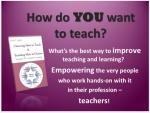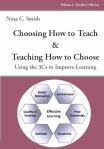Being a teacher makes our core values become visible. All the small (and bigger) choices we make in the classroom talk about our beliefs of good learning and teaching: how we place our students, what kind of questions we ask, what is valued in our class, etc., and they all also contribute to our students' perception of education. Improving learning and teaching becomes easier when we empower every teacher with the knowledge of choices. Please watch and share:
Taking time to think HOW exactly YOU want to teach makes all your choices become more conscious. It is easier to choose wisely when you have better understanding about the consequences of your choices. Walking the talk of making well-informed choices is important for everyone who wants to teach. Fortunately choosing is a skill that grows with use, just like language fluency.
The same principles apply to our students: they need to have opportunities to practice choosing in an emotionally safe learning environment. The first step is to make students aware that there is a choice. So, how exactly do we help our students to make wise choices? This thinking process led me to write the book:
My own belief, based on experiences, is that independent and autonomous students are also the most successful ones. I think this happens because they have so good control over their own learning processes, and also use several different learning strategies. Guiding all students towards being self-sufficient and having more successful learning experiences can be done if we let go of some unnecessary control and start providing more choices in the daily classroom situations.
Please note that I am not talking about students running wild in the class. The best environment to improve learning and practice choosing is where we can allow students to make mistakes without penalties. This of course means having informal and non-punitive assessment and self-evaluation systems in place. Student accountability is built on the foundation of their autonomy. How could you be accountable for something you cannot control?
How can you help students practice choosing and become more independent in their learning?


No comments:
Post a Comment